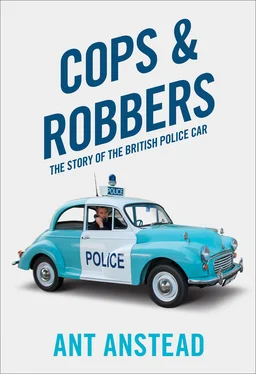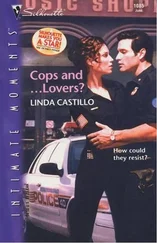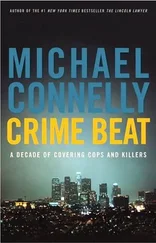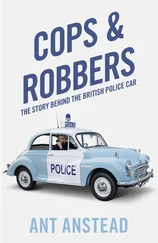Unfortunately, Crossley never built a car that captured either the government’s or the public’s imagination in the same way again and eventually ceased making cars altogether in 1937. They continued to make trucks, though, and were acquired by the Associated Commercial Vehicles Group, better known as AEC, in 1948, who acquired Maudslay at the same time. The Crossley name faded away in 1956 and eventually became part of the British Leyland melting pot. It was a sad end for the marque that had been the backbone of the British military’s move to motorisation during World War I and subsequently provided the UK’s earliest police patrol and response vehicles. Rest in peace, Crossley.
The Crossley also played its part in the formation of the Flying Squad, formed in October 1919 after a post-war crime surge; it became known as ‘Sweeney Todd’ in rhyming slang quite quickly, then just Sweeney, and initially consisted of just 12 officers. Manchester City Police followed London’s lead in forming what was originally called a ‘Mobile Patrol Experiment’ and patrols were made using a horse-drawn carriage that had been borrowed from a railway company. However, it was soon re-organised and issued with Crossley Tenders, the first vehicles used in Britain for actual police work rather than just moving things and people between police facilities. The Crossleys were heavy and fairly simple beasts that were apparently quite easy to skid in wet weather, but they did provide a good basis for patient underworld observational work and were used successfully in this role. They were much loved by the officers who used them because they were reliable and capable workhorses. Most were fitted with van-type backs, or, at the very least, a canvas tilt. They were actually liveried at times with false trade names to appear as delivery vehicles or furniture removal vans to aid their undercover work, the first time this was ever done in the UK and probably even around the world. These disguises were easy to believe because, as discussed, war-surplus vehicles were very common in the early 1920s, although apparently it was quite some while before most criminals cottoned on to the fact that the police also owned some of these vehicles. However, by the mid-1920s these vehicles had become outmoded and had begun to be replaced.
By May 1926, just as the TUC called a General Strike that plunged the country and the government into conflict with the unions, the Met’s fleet consisted of 202 cars:
• 6 Austin saloons, used by the Commissioner and his assistants.
• 2 Austin ambulances.
• 6 Bean saloons, used by HQ personnel.
• 5 Bean saloons, used by CID.
• 4 Bean saloons, used by District Chief Constables.
• 12 Bean saloons, used by Superintendents in outer areas of the Met’s jurisdiction.
• 4 Bean saloons, used as spares by whoever needed them.
• 18 Bean vans, used on inner and outer dispatch services.
• 4 Bean vans, used for accumulator service.
• 6 Bean vans, used as spares by whoever needed them.
• 17 Tilling Stevens, used as prison vans.
• 1 Dennis, used as a prison van.
• 52 Crossley Tenders for many and varied uses from Flying Squad to radio testing and everything in between
• 41 Triumph Solos and Combinations, used by sub-divisional and Detective Inspectors for patrolling.
• 24 Chater-Lea Combinations, used by sub-divisional Inspectors and Inspectors for patrolling.
And that is the last list of cars you will see in this book – you’re welcome!
The General Strike is important in the history of the police car because it marked the very beginnings of police officers being moved around to deal with troubles, something I became all too familiar with in my time as a police (and especially PSU/Riot) officer. This particular role depended on motorised transport to get officers to scenes quickly, and the lack of this sort of capability within various UK police forces was soon exposed nationally to both the government and media. From this time on, policing fleets got bigger and bigger across the UK. At the early stages of researching this book we did look at trying to come up with a definitive list of cars that the police have used, but we gave up quite quickly, simply because it encompasses pretty much everything, with local forces sourcing cars individually and in some cases buying used as well as new, especially immediately after World War II. No records exist for many forces, and in the early days local philanthropic lords of the manor would sometimes even loan cars to the police as a gesture of public spirit, which meant that police officers were sometimes seen in the most unlikely of vehicles, from station wagons to Rolls-Royces. I can’t imagine a member of the public today lending their car to the police to borrow. I wouldn’t!
The Roads Act 1920 had established the Road Fund licence and introduced tax discs to windscreens. This scheme was run by local councils, which meant it was fairly easy to register a car with a number plate that was also being used elsewhere because there was no central list of vehicles at this stage. The criminal fraternity exploited this regularly (as I discussed on the Channel 4 show The Lost Lotus , following my restoration of a mysterious Lotus Elite); a UK-wide system of checks was not properly introduced until the DVLA started to computerise information in the mid-seventies. This legislation, and consequent government revenue, was needed though, because by 1930 vehicle numbers had risen to a million (when the UK population was around 45 million, around 20 million less than it is as I write this book in 2018), but drivers were not educated in how to handle their cars in terms of etiquette, skill or plain common sense. Road deaths and casualties were rising alarmingly, and while the prevailing attitude was a feeling that ‘one took that risk if one drove’, the government felt they had to do something. Cars in this period were improving rapidly as well, getting cheaper and faster every year, with better handling and brakes. I’ve driven vintage cars (can I just say, vintage actually has an official meaning in the car world, referring to cars from post-1918 and up to 1930. Everything seems to be described as vintage these days, from Mk1 Escorts to 60s plastic handbags. Gosh, I sound like my dad!) and while they may seem, to modern eyes, very heavy to drive and possessing very poor brakes, they are much more usable than their pre-Great War cousins. It’s quite possible to cruise at motorway speeds in the larger-engined vintage cars (remember vintage also encompasses Austin 7s and similar economy cars, but somehow the term ‘vintage car’ produces a picture of a Bentley in the mind’s eye, or is that just me?) and they have 4-wheel brakes which, if properly adjusted and maintained, can actually stop a car reasonably well.
This increase in the performance of cars (and, perhaps perversely, the improved brakes as well, for humans will often go faster in a car that has good brakes! Indeed, legendary designer Alec Issigonis has been cited as saying ‘putting a dagger on the steering column would lead to a great improvement in driving standards’ and he was only half joking) led to the 20mph speed limit being so widely ignored as to be laughable, and the Road Traffic Act 1930 effectively removed speed limits, which caused much public debate. However, in short this was done because the speed limits then were just not enforceable and had become a joke. In fact, it was stated in Parliament in 1931 that, ‘the reason why the speed limit was abolished was not that anybody thought the abolition would tend to the greater security of foot passengers, but that the existing speed limit was so universally disobeyed that its maintenance brought the law into contempt’. So many people were breaking the speed limit that the police could not cope and the government dealt with this not by increasing the police’s budget or improving the equipment at their disposal, but by getting rid of the law! The police had realised the situation was untenable and had by then been lobbying politicians to deal with this unenforceable law, and, certainly in the post World War I era, enforcing it with a light touch – code for often not enforcing it at all because they simply did not have the manpower to do so, although officers seeing driving they considered reckless or dangerous certainly did intervene, at their discretion …
Читать дальше








